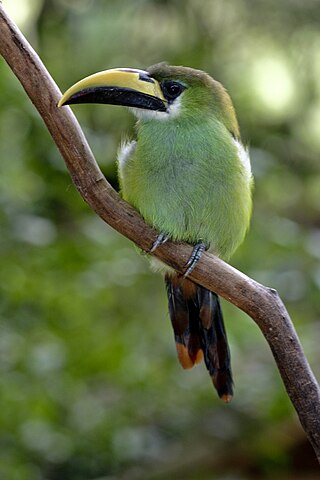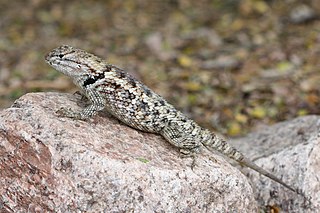
Spiny lizards is a common name for the genus Sceloporus in the family Phrynosomatidae. The genus is endemic to North America, with various species ranging from New York, to Washington, and one occurring as far south as northern Panama. The greatest diversity is found in Mexico. This genus includes some of the most commonly seen lizards in the United States. Other common names for lizards in this genus include fence lizards, scaly lizards, bunchgrass lizards, and swifts.

The emerald toucanet is a species of near-passerine bird in the toucan family Ramphastidae. It is found from Mexico to Nicaragua.

Sceloporus magister, also known as the desert spiny lizard, is a lizard species of the family Phrynosomatidae, native to the Chihuahuan Desert and Sonoran Desert of North America.

Sceloporus poinsettii, the crevice spiny lizard, is a species of small, phrynosomatid lizard.

The eastern fence lizard is a medium-sized species of lizard in the family Phrynosomatidae. The species is found along forest edges, rock piles, and rotting logs or stumps in the eastern United States. It is sometimes referred to as the prairie lizard, fence swift, gray lizard, gravid lizard, northern fence lizard or pine lizard. It is also referred to colloquially as the horn-billed lizard. One of its most notable behaviors is that of its escape behavior when encountering fire ants.

The sagebrush lizard or sagebrush swift is a common species of phrynosomatid lizard found at mid to high altitudes in the western United States. It belongs to the genus Sceloporus in the Phrynosomatidae family of reptiles. Named after the sagebrush plants near which it is commonly found, the sagebrush lizard has keeled and spiny scales running along its dorsal surface.

The Texas spiny lizard is a species of phrynosomatid lizard native to the south central United States, in the states of Texas, Arizona and Oklahoma, and northeastern Mexico in the states of Coahuila, Nuevo León, Tamaulipas, and San Luis Potosí. They are quite common throughout their range, where they can be found in trees or on fences.

Ctenosaura pectinata is a species of moderately large lizard in the family Iguanidae. The species is native to western Mexico.

Sceloporus serrifer, the rough-scaled lizard or Yucatecan rough-scaled lizard, is a species of phrynosomatid lizard.

The spiny-tailed monitor, also known as the Australian spiny-tailed monitor, the ridge-tailed monitor the Ackie dwarf monitor, and colloquially simply ackie monitor, is an Australian species of lizard belonging to the genus of monitor lizards (Varanus).
Plasmodium beltrani is a parasite of the genus Plasmodium subgenus Sauramoeba. As in all Plasmodium species, P. beltrani has both vertebrate and insect hosts. The vertebrate hosts for this parasite are spiny lizards.

The southwestern fence lizard, also known as Cowles' prairie lizard, the White Sands prairie lizard or the White Sands swift, is species of spiny lizard in the family Iguanidae. The species is native to the Chihuahuan Desert of the south-western United States and north-central Mexico. Originally described in 1956 as Sceloporus undulatus cowlesi, a subspecies of the eastern fence lizard, subsequent DNA studies elevated the southwestern fence lizard to species status.

Sceloporus jarrovii, also known commonly as Yarrow's spiny lizard, is a species of lizard in the family Phrynosomatidae. The species is native to the southwestern United States and northern Mexico. There are two recognized subspecies.

Sceloporus lundelli, also known commonly as Lundell's spiny lizard and la espinosa de Lundell in Mexican Spanish, is a species of lizard in the family Phrynosomatidae. The species is native to the Yucatán Peninsula in Mexico, Belize, and Guatemala. There are two recognized subspecies.
Sceloporus taeniocnemis, also known commonly as the Guatemalan emerald spiny lizard and la chachapaja in Spanish, is a species of lizard in the family Phrynosomatidae. The species is native to Guatemala and adjacent southeastern Mexico. There are two recognized subspecies.















